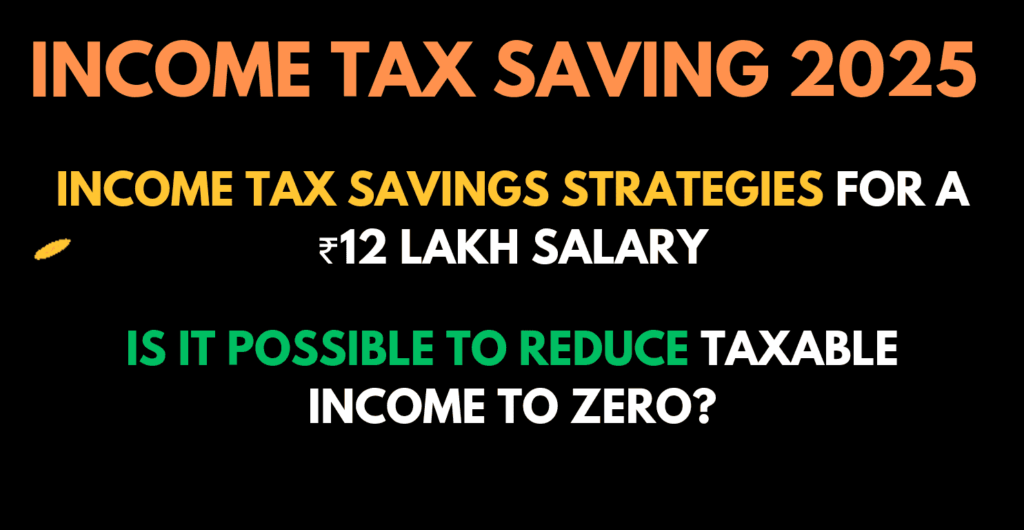Income Tax Savings Strategies for a ₹12 Lakh Salary, is it possible to reduce taxable income to zero?

Overview
Here we outlines strategies for effectively saving income tax for individuals earning an annual salary of ₹12 lakh. By utilizing various tax deductions, exemptions, and reimbursements, it is possible to reduce taxable income to zero. We emphasizes the importance of proper financial planning and understanding tax regulations to maximize savings.
Key Points
- Effective Planning: Proper financial planning can lead to zero income tax on a salary of ₹12 lakh.
- Utilization of Reimbursements: Leveraging reimbursements can significantly reduce taxable income.
- Salary Structure Adjustment: Changing the salary structure allows for better tax management.
- Housing Rent Allowance (HRA): Claiming HRA correctly can lead to substantial tax exemptions.
- Understanding Tax Calculations: Grasping the calculations for taxable and non-taxable income is crucial for maximizing tax savings.
Detailed Breakdown
Effective Planning
We personaly stresses that with the right planning, individuals can save on income tax. This involves understanding and utilizing tax deductions and exemptions allowed under the Income Tax Act.
Utilization of Reimbursements
To avoid high taxable income, individuals should structure their salary to include various reimbursements. Common reimbursement categories include:
- Conveyance: Expenses related to travel for work.
- Leave Travel Allowance (LTA): Costs incurred while traveling for vacation.
- Entertainment and Food Coupons: Benefits provided by employers that can reduce taxable income.
- Broadband and Petrol Bills: Reimbursable expenses that can further decrease taxable income.
Salary Structure Adjustment
Employees can request their HR departments to modify their salary structure to maximize tax benefits. This may include increasing the proportion of reimbursements and allowances in their salary package.
Housing Rent Allowance (HRA)
HRA is a significant component for tax savings. The exemption calculation involves three key figures:
- The actual HRA received.
- The rent paid minus 10% of the basic salary.
- 50% of the basic salary for individuals living in metro cities, or 40% for those in non-metro areas.
By effectively claiming HRA, individuals can exempt up to ₹1.80 lakh from their taxable income.
Understanding Tax Calculations
The article provides a breakdown of how to calculate taxable and non-taxable income:
- HRA Exemption: Up to ₹1.80 lakh.
- Total Reimbursement: Approximately ₹1.98 lakh.
- Total Deductions: Up to ₹3 lakh.
- LTA Exemption: ₹30,000.
After accounting for these exemptions and deductions, the taxable income from a ₹12 lakh salary can be reduced to ₹4.92 lakh.
Rebate under Section 87A
For taxable income less than ₹5 lakh, individuals are eligible for a rebate under Section 87A. The tax on the portion of income between ₹2.5 lakh and ₹5 lakh is 5%, but the rebate can effectively nullify this tax, resulting in a total tax-free income.
In short
- Total annual salary: ₹12 lakh.
- Taxable income after exemptions and deductions: ₹4.92 lakh.
- Potential tax-free income: ₹7.08 lakh through strategic planning.
- Section 87A rebate: Up to ₹12,500, ensuring no tax on incomes below ₹5 lakh.
Final Takeaways
By implementing strategic financial planning, adjusting salary structures, and effectively utilizing available exemptions and deductions, individuals earning ₹12 lakh annually can achieve zero income tax liability. Understanding the nuances of HRA, reimbursements, and tax rebates is essential for maximizing savings and ensuring compliance with tax regulations. Proper management of these elements can lead to significant financial benefits, enabling individuals to retain more of their earnings.